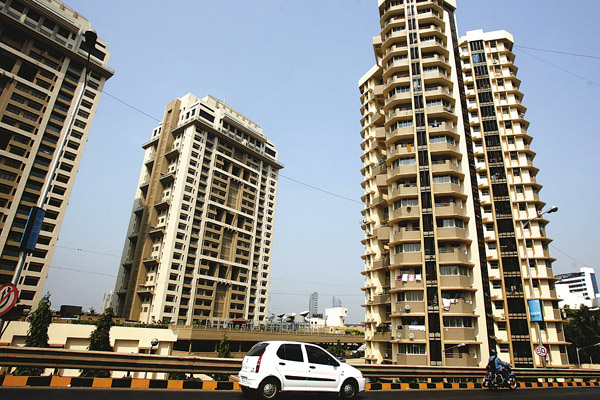
Sanjay Dutt: On Firm Ground
The outlook for India’s real estate sector is largely positive with Mumbai continuing to be the most attractive market, says real estate expert Sanjay Dutt
Sanjay Dutt
profile: CEO — Business, Jones Lang LaSalle, India
Education: Did his bachelor’s degree in commerce from University of Delhi and Program in Business Management from International Management Institute (IMI), New Delhi
career: Has 22 years of experience as entrepreneur and services-sector professional in the logistics and real estate industries. He has spent 13 years as a real estate professional in Mumbai
The Indian real estate sector is full of contradictions. The demand- and supply-side dynamics change every few kilometres in most cities, making it all the more difficult to look for a definite trend. But one can conclusively say that construction activity in India, despite poor sentiments, is positive.
Over the past five years, the market value of investment-grade real estate under construction has grown about 20 percent to touch $160 billion. However, the last few quarters haven’t been good, largely because of over-enthusiastic developers. They ignored market sentiments, cyclical risks and over-leveraged their positions. They had over-ambitious plans that led to oversupply in some cases and extremely high prices in others.
Again, like everything else, the gloom in the global environment hurt the sector. So what does 2012 have in store for the key players in real estate — occupier, investor and developer?
The occupiers are cautious, the investors are nervous and the developers are selling more land than what they are buying . The exuberance of 2010 created excessive office space, currently over 56 million square feet, and took vacancy levels to over 22 percent.
The rents at IT parks in Lower Parel, Mumbai, have come down from their high of Rs. 200 per square foot (psf)/month to Rs. 90-Rs.150. But the good news is that space is being leased and sold faster than ever before.
This is because corporate India sees the high vacancy rates as an opportunity to buy — rather than rent — their office space. The low price is also seen as an opportunity to buy by investors who are betting on demand to rise.
Residential property forms the bulk of Indian real estate. Sustainable buying is seen in areas where space is sold at Rs. 2,500-Rs. 5,000 psf across India. In 2008, the National Capital Region (NCR) was the first market to go down in volumes, while Mumbai was the last. But both bounced back in the third quarter of 2009 and exceeded previous highs by 2010. But this was short lived as interest rates went up and sentiments went down.
The rest of the country, however, saw high volumes and capital appreciation throughout 2010 and the first half of 2011. But it went the NCR and Mumbai way later on. There is oversupply in cities like Pune, Bangalore and Chennai and they will find it difficult to take off for the next two years. But the worst market was Hyderabad which was hit hard due to the Telangana stir.
Mumbai continues to be the most attractive. New residential developments of about 22 million square feet are expected to come up in central Mumbai.

Therefore, investors are willing to pay a premium for residential projects at Vivaria (Mahalaxmi, Mumbai), Ashoka Gardens, Bellissimo and Planet Godrej — which have been completed or are in their final stages of completion.
Against this backdrop is another story: Several high-profile residential developments — mostly high-rises that haven’t been attempted in India so far and with significantly high cost of construction — are giving investors the jitters. They are demanding a discount on the basis of time value of capital and market sentiments.
Growth is a basic fundamental to qualify a location. Residential land or apartments are typically in locations where there is good social infrastructure, public transport and economic activity to sustain development.
This, if restricted to tier 1 and tier 2 cities, reduces investment risk. Further, if you invest Rs. 2,500-Rs. 5,000 psf, it gives downside protection from any capital erosion.
Simply put, the cost of construction and minimum cost of land literally makes this price segment safe and almost guarantees capital appreciation. Some of the markets that qualify would be NCR, Lucknow, Chandigarh and Jaipur in the north and Ahmedabad in the west.
Investors should ensure that the price of the property is lower than the last peak in 2008. Exceptions should be made only for quality, delivery date and location.
Investment in offices, whether speculative or leased, requires one to factor in non-real estate factors as well and a better understanding of the macro economic picture. I highly recommend growth corridors of Mumbai like Goregaon East and Thane Belapur Road as they cost less, are closer to suburban workforce catchments and give you better quality construction.
Lastly, you are making an investment for rental income [yields] of at least 10.5-11 percent as interest rates are high and some buyers would have taken loans to buy a property.
The only rationale to settle for a lower yield should be if capital values are a lot below the market.
You must review your portfolio every three years. Review it six months prior to rental renewal or expiry of the lease and take a call if you want to exit or continue to stay invested in the property.
(As told to Pravin Palande)
(This story appears in the 20 January, 2012 issue of Forbes India. To visit our Archives, click here.)
-
 Manish
Manishit's is a boost to real estate with facts
on Jan 20, 2012















